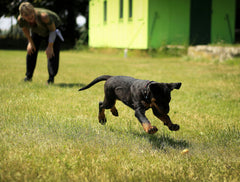
Rabbits are the symbol of spring, and the most adorable to adopt. However, there is a lot to consider before you decide to adopt a pet rabbit. Let’s go over the history of the Dutch rabbit, what they’re like, how to care for them, and their temperament is to decide if adopting a Dutch rabbit is right for you.
Dutch Rabbit Origin

Did you know that the Dutch rabbit breeds are one of the oldest domestic rabbits out there? In fact, it descends from Petite Brabançon of the Brabant region of Holland sometime around 1850, called the Hollander rabbit. Then, it journeyed to England where the Dutch rabbit grew in popularity and now is domesticated in many areas around the world.
What Does the Dutch Rabbit Look Like?

The typical Dutch rabbit is a rounded body that is small and compact. Its head is rounded with short and broad ears. Their back legs are typically longer than the front legs, too. The rabbit’s coat is short, glossy, and pretty easy to care for. Though, remember this breed of rabbit also sheds seasonally. Remember to groom your rabbit more often during these times, sometimes daily. Otherwise, do brush your rabbit’s coat about once a week. Most Dutch rabbits have similar markings; with dark-colored ears and behinds and a white band from the shoulder tops to their bellies, and white legs and white fur in the front of the face (also known as the ‘Blaze’).
Some Dutch rabbits have pure white and slate black fur along with dark brown eyes, there are also tri-coloured dutch rabbits. Then, there is the Blue Dutch with eyes that are blue-grey and medium-dark blue and glossy fur, and the grey Dutch rabbit. Finally, there’s the Chinchilla Dutch, with dark brown or blue-grey fur and a speckles grey and white look. Other recognized Dutch rabbits are the Chocolate Dutch, with dark brown/ruby eyes and Chocolate colored fur. Then, the Gray Dutch with a mixed fur of blue, tan, charcoal brown, and chocolate brown and brown eyes. Finally, the Steel Dutch rabbit with dark brown eyes and a black body and some off-white hair tips and the Tortoise Dutch with orange coloring and dark brown eyes.
Caring for a Dutch Rabbit

Like most rabbits, the Dutch rabbit likes to be outside its enclosure so they can run and play. These rabbits love to jump high, especially in the green grass. It’s recommended that you set up a playpen for your rabbit to run and play.
As long as you give your dutch rabbit a diet of 70 percent hay, fruits, veggies, and pellets, your pet will live a long and happy life. Remember that some fruits and vegetables can be a risk to your rabbit’s health. Research each fruit and vegetable before feeding it to them. Seeds from fruits in apples and pears can contain tiny particles of cyanide, so steer clear. Cherry twigs, mushrooms, rhubarb, and bark should be avoided at all costs as well.
If you have your rabbit in an enclosure, you can keep them indoors out outside, depending on your weather. Try not to let them out in extreme heat and cold as they do not do well in either environment. Always keep their enclosure as clean as possible along with hay bedding (about once every other day this should be cleaned).
Owning a Dutch Rabbit is different than owning a dog or a cat because of the type of environment he or she will be living in. Wire cages only hurt their fluffy feet, so try to make them as comfortable as possible. So, what should they live in?
Many do wonder if they should do a wire enclosure or bedding. Though, rabbits are happier in bedding because it is better on their feet and comfy. Though, humans prefer wire enclosures for the ease of cleaning. So, it’s best to purchase an enclosure with a hay bottom if you want an enclosure that is more comfortable for your rabbit. You will spend more time cleaning it, but your rabbit will be happier and in better shape without the wire on their feet. Do clean out enclosures like this once a week and remove droppings daily.
Dutch Rabbit Health

Did you know that a rabbit’s teeth never stop growing? However, due to normal daily chewing and grinding, their teeth wear down. Do keep an eye on your rabbit’s teeth for signs of infection as they can start growing into their jaw and face if overgrown. Signs are drooling, loss of appetite. That means you must check your rabbit’s teeth very often and take them to the vet at any sign of infection to be treated with antibiotics.
Remember to spay your female rabbit at as young as four months old and male rabbits should be neutered as young as three and a half months old. In addition, it’s important for your rabbit to get worm prevention treatment as well as checks for fleas and ticks.
Dutch Rabbit Behavior

Rabbits love to be out and about, outside their enclosure. These rabbits are also gentle, which means they get along well with children as long as they are handled well. If they’re out of their enclosure enough, they will become social. However, too much time in their enclosure can make them depressed and bored, especially without a companion. These rabbits are low maintenance. Simply provide them the right environment, food, and playtime to hop about.
Training a rabbit is much different than training a dog or cat. Before training, know that peeing in the corner of a room or scratching the floorboards or chewing wires is completely normal to them. You can’t really punish them, either. Rewards such as treats, however, go a long way. It’s important you do not get angry and shout at your rabbit as they will then consider you an enemy and refuse further training. It’s instead important to be patient when training your rabbit to go to the bathroom or learning tricks.
Dutch rabbits are not difficult pets to own. They only require a bit of tender love and patience. Learning and adapting to the rabbit’s lifestyle is key as rabbits are different than having a cat or a dog. The reward for the proper care and nutrition of a rabbit is a long-living and loving relationship with your pet.
How long do Dutch rabbits live?
Generally, Dutch rabbits live for around 5 to 8 years if they are properly cared for. Wild Dutch rabbits also tend to live shorter than average.
How big do Dutch rabbits get?
Dutch rabbits vary in size, but generally, this breed is small. They weigh between 3.5 and 5.5 pounds and usually stop growing by the age of 6 months. These compact size animals may be small, but they have a lot of love to give!
What do Dutch rabbits eat?
Like most rabbit breeds, Dutch rabbits eat greens and fruits. Their diet consists of 70% hay and some leafy greens and vegetables. Vegetables like basil, bok choy, broccoli, celery, cilantro, and kale are good for them. For fruits, you may want to give them something with lesser sugar content like strawberries and pineapples.
Check out our blog and follow me on LinkedIn to stay up-to-date!





Comments
Looking for purebred Dutch, black or steel. A pair or a trio. Ship to
. Arizona